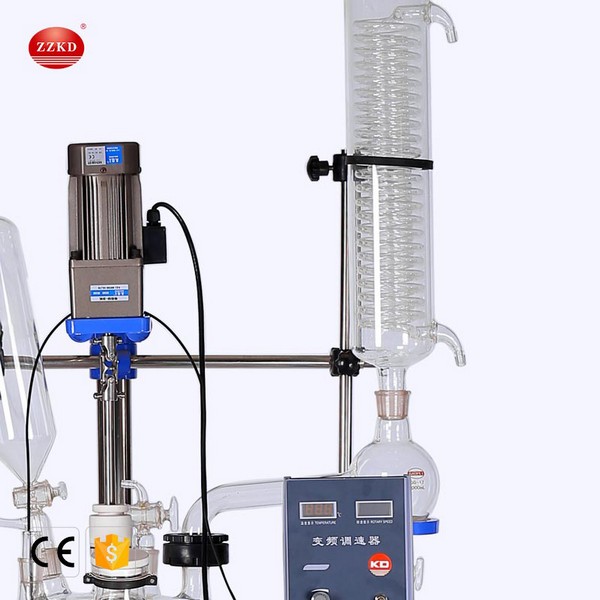How Do Jacketed Laboratory Reactor Work?
Jacketed Glass Reactor
The heat transfer jacket is generally welded by a steel plate, which is a container that can form a sealed space outside the reactor cylinder, and is simple and convenient. When the steam is passed through the jacket, the steam pressure generally does not exceed 0.6 MPa. When the diameter of the 1l jacketed reactor is large or the heating steam pressure is high, the jacket must be strengthened.
The spacing between the jacket and the inner wall of the jacketed laboratory reactor is different depending on the diameter of the reactor, and is generally 25 to 100 mm. The height of the jacket depends on the heat transfer area, which is determined by the process requirements. However, it must be noted that the height of the jacket should generally be higher than the height of the liquid, and should be 50~100mm higher than the liquid level in the kettle to ensure sufficient heat transfer.
Sometimes, chemglass 20l jacketed reactor for larger stirred tanks, in order to improve the heat transfer effect, a spiral baffle is installed in the jacket space to reduce the flow area of the fluid in the jacket, increase the flow rate and avoid short circuits. The spiral baffle is generally welded to the wall of the kettle and has a gap of less than 3 mm from the wall of the jacket. After the spiral baffle is added, the coefficient of the heat transfer film on the jacket side can generally be increased from 500 W/(m2•K) to 1500-2000 W (m2•K).

Use of glass reactor:
1.Check that the power supply voltage meets the specifications provided on the machine nameplate.
2. Plug in the power plug, turn on the power switch on the inverter, and use the speed control knob to select the appropriate speed.
3. The flow of material and the power of the motor speed may resonate at a certain point. Please change the speed of the motor to avoid resonance.
4. As shown in Figure 4, after the rod is installed, it should be rotated by hand, pay attention to whether the concentricity is good, just like the heart is not good, to loosen the pinch, correct the pinch, then turn on the power, gradually adjust from slow to fast.
5. Use a stir bar adjuster to stir up and down 5 cm as needed.
If the seal performance of the kettle is found to be degraded, check the rotary bearing inside the mixing sleeve.The glass apparatus of the reaction apparatus is made of G-17 low expansion coefficient and high temperature high quality borosilicate glass. The user has his own glass instrument, such as a reaction bottle. Please confirm the quasi-glass material to ensure safe use.
6.outside the compartment circulating on the glass kettle, hot oil can be used to heat the reaction, can be carried out on the cooling liquid low temperature reaction, such as steam heating, not more than 0.5K-1K. (Try not to use pressure steam to heat).
7.in the low temperature test, the bottom of the discharge valve will be frosted, the use of the valve must be partially thawed to prevent glass breakage.
8.If there are particulate objects in the solution in use, the residue can be stored on the PTFR piston of the valve when the material is placed. When used again, air tightness is affected. It must be cleaned and reused after each discharge.

Glass reactors must comply with the following rules:
1. Read the full statement.
2. The additional electrical parameters of the socket provided by the user shall not be less than the additional electrical parameters of the machine and shall be well grounded.
3. When replacing the fuse, the plug must be inserted from the socket.
4. After the failure of wires and electrical equipment, repair by professional personnel.
5. The image of the child is unique and should be taken seriously.
6. During this process, it is forbidden to put your fingers into the gap between the steps.
7. It is strictly forbidden to move the jacketed laboratory reactor during walking.
8. The working platform of the jacketed laboratory reactor should not be too greasy (such as tiles, etc.).
9. The glass reaction kettle is present separately at a high point and should be protected.
10. Unplug the power supply when cleaning the machine

Features:
1.GG17 high-borosilicate glass with nice physical-chemical properties; experiment temperature -100 to 400 degree C;Resistant to strong acidic properties of materials; only touching with glass parts & PTFE,no cross-contamination.
2.Precision Mechanical seal stirring to keep high vacuum degree.
3.Glass(PTFE)discharge valve,no-dead angle mixing,fast no residue discharge.
4.Frequency control speed gear motor,smooth running,higlh torque,automatic booster.no spark,noise free,long life.
5.SUS frame and cast aluminum material kettle body support,simple as well as strong;stable structure.
6.Circulating water/oil bath,heating mantle can supply the heating origin;Cooling mode machine:cool chiller,convenient and practical.
7.Scientific & innovative structure,practical,strong.
NowF-2L, F-10L, F-50L, single layer glass reactor are on sale.